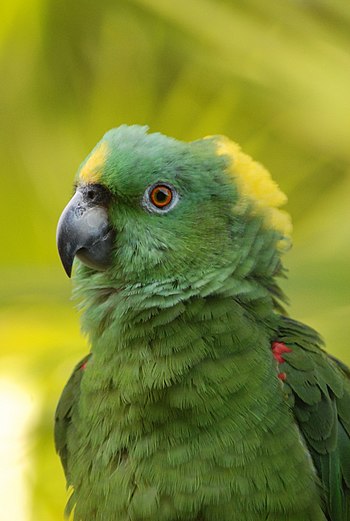 |
| Timneh African Grey Parrot (Psittacus erithacus timneh) – subspecies of the (Psittacus erithacus). Pet parrot sanding on a cage. (Photo credit: Wikipedia) |
In order to keep them healthy, owners must be ever vigilant about perils that could, in the blink of an eye, take them from us. Here are 5 of the most common perils that face pet parrots and suggestions for how to avoid them.
1. Food Toxicity-When deciding on the best diet for your parrot, you have certainly seen warnings about various people foods that can have devastating consequences if ingested by your bird. These include but are not limited to avocados, chocolate, alcohol, caffeine, sugar, and peanuts. There are several other things to be careful about.
When putting fresh food out (and you should do this daily if possible), make sure you allow the food to stay in the cage for only an hour or so. As you become more aware of your pet’s eating habits, even 30 minutes may be long enough. But the important thing to remember is to remove fresh food before your bird has any chance of ingesting food that is moldy. This can have grave consequences. Change water as often as it takes to keep it fresh.
Feeding your parrot small portions will round out his nutritional requirements by allowing you to feed it a little bit of all the types of food he needs rather than too large a portion of any one food.
2. Injury Outside the Cage-One of the most frequent demises of parrots happens when they are outside the cage. Be sure to go over rooms that you intend to let your bird explore before you release it from the cage. Hide wires, and protect those that are visible from being chewed by encasing them in heavy-duty plastic hoses. Turn off ceiling fans, cover mirrors, and close draperies to prevent your parrot from flying into them.
Put covers on pots on the stove, and put the top down on the toilet. Limit access to other pets while your parrot is on the loose, particularly if there is any chance that there might be aggression for any reason. Avoid opening doors to the outside especially if your bird is a strong flier. Always supervise your parrot closely when it is out of the cage.
3. Injury Inside the Cage-Often injury inside the cage results because the cage is too small or the bars on the cage are big enough for a head or some other extremity to get caught in. Double check the cage you select to make sure it does not have harmful metals or paints that are toxic. Parrots have incredibly strong beaks, so be certain the cage is strong enough to stand up to those powerful jaws. Stainless steel cages take the worry out of this problem because of strength, longevity, and lack of toxins.
4. Dangerous Toys-Because parrots are such strong chewers, a toy that was safe one day may become chewed until it is not. Monitor toys closely and rotate unsafe toys out immediately replacing them with new or other toys that are still safe.
5. Disease and Infection-Birds are programmed to hide illness because in the wild illness would make them subject to attack. So, unfortunately, disease and infections in parrots are often irreversible by the time they exhibit any symptoms. However, cleanliness plays a large part in keeping your bird healthy. Clear away droppings daily or more often if necessary. This keeps minuscule pieces of dried feces from becoming an airborne and spreading disease. Wash food and water dishes daily. Keep floors and walls in the bird’s room clean, and completely sanitize the cage monthly.
You should also keep the air clear of dander, dust, feather and other airborne pollutants that are present in your home’s air even without a parrot. Normal household pollutants such as dust, dust mites, mold and mildew spores, pollen, other pet dander can all combine to clog your bird’s air passages which makes your parrot more susceptible to illnesses.




